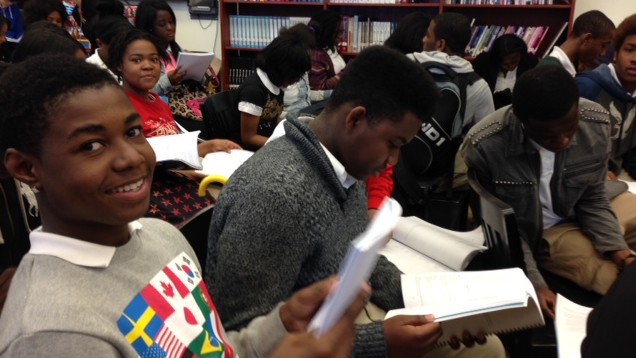“Writing sijo is like all art, I tell them: It’s important to understand the rules, but once you do, it is sometimes necessary—and acceptable—to break them.”
To help my students engage in the writing process I like to design assignments that give them an opportunity to publish or gain recognition for their work. One of my favorite such opportunities is The Sejong Cultural Society’s annual poetry competition for sijo, a traditional Korean poetic form that is still in use today.
The Sejong Cultural Society describes sijo (pronounced SHEE-jo) as “a traditional three-line Korean poetic form typically exploring cosmological, metaphysical, or pastoral themes.” The contest is meant to increase awareness and understanding here in the U.S. of Korea’s cultural heritage.
The writers of the winning poems receive cash prizes and this—as well as the contest’s association with Harvard University through their Korea Institute—usually piques my students’ interest. I also make sure to let my students know that a number of our high school’s alumni have placed in the competition, so that they understand this is possible for them, too.
And each year I write alongside with my students and submit to the Sejong Cultural Society’s adult sijo competition. My goal is to not just to model what it is to be a lifelong learner, but also to allow my students to see that I share their struggles and feelings of vulnerability as a writer.
Sijo Structure
Like the Japanese haiku, the sijo is a three-line poem constructed around syllable count. In sijo, however, there are four groups of syllables in each line. These groups of syllables “should be clearly differentiated from the other groups, yet still flow together as a single line,” according to the rules of the form, stated in the contest. In addition to syllable requirements, each line also has a purpose.
| Syllable Groupings Line one: 3, 4, 4, 4 Line two: 3, 4, 4, 4 Line three: 3, 5, 4, 3 | Purpose Line one: introduction Line two: development Line three: twist and conclusion. |
My students understand how a plot is developed, so we discuss the introduction in the first line of the poem in these terms: An introduction must engage a reader in the topic by introducing characters, a point of view, plot, setting, or tone.
Line two, I explain, is where they will find the rising action of the poem. It’s where the tension builds. In line three, we come to the climax of the poem, which arrives in the form of a twist, followed by a conclusion.
To help my students understand how the twist works in this last line, we make a list of things that might create a sense of surprise.
| Twist Possibilities something unexpected, something shocking, a joke, a play on words, a turn or bend, a shift in plot, a mood change, a change in perspective. |
Once my students have a grasp of the form, I let them know that it allows for some flexibility. Writing sijo is like all art, I tell them: It’s important to understand the rules, but once you do, it is sometimes necessary—and acceptable—to break them. Poets should aim for the specific syllable groupings the form requires—a poem can be eliminated by the judges if the structure is too far off base—but small deviations from the form are allowed if they serve the poem’s meaning. One of the judges of The Sejong Cultural Society’s sijo competition, Professor Emeritus of Korean history at Brigham Young University Mark Peterson, puts it this way: “The structure is important, but I always allow for ‘poetic license’ meaning that sometimes the message is more important than the structure.”
Looking at Previous Winning Student Poems
“I never heard of this form of poetry and now it’s one of my favorites. I didn’t do this poem to win the competition; instead, I did the poem to express myself through writing.”
After we finish going over the structure and form of sijo—with its syllable groupings and counts, its twists and scaffolded content, it’s understandable that some students might feel overwhelmed. I’ve found inviting students to read and analyze previous winning poems helps alleviate their anxiety and feelings of intimidation. It also helps them see the how the form works in practice and discover possibilities for their own poems. I often start with a sijo written by my former student Austin Snell. Austin’s poem won first place in the 2016 contest.
Emma
My new dog, little Emma, a gift to us from the heavens.
— Austin Snell
My aunt passed, stupid cancer, my mom distraught. Everyone muted.
I could look into Emma’s eyes, she’s still here, on four paws.
We read the poem together in class and I ask students to respond.
They tell me it’s about death, dying, illness, sadness, bereavement, mourning, and processing. They tell me it’s about finding light in darkness—about cancer, a topic many of them connect with. They observe that line one is about the dog and line two is about family members, while the third line combines both and focuses the poem on healing and honoring a loved one.
Next I ask the students to identify the total number syllables in each line (15, 16, 14) as well as the syllable groupings, and then to add up the number of syllables in the poem as a whole (45). Once they have done this we talk about how Austin used punctuation, topic, tone, and rhythm to distinguish one syllable grouping from another.
My new dog, little Emma, a gift to us from the heavens. (3, 4, 4, 4)
My aunt passed, stupid cancer, my mom distraught. Everyone muted. (3, 4, 4, 5)
I could look into Emma’s eyes, she’s still here, on four paws. (3, 4, 3, 4)
Finally I share with students what Austin said about his poem:
“I would love to thank my Aunt Eli who passed away after battling cancer. She was the inspiration for my sijo. She was the kindest and most honest person I will ever know. We knew my aunt’s cancer had come back the same year we got our new dog. My mother was in complete despair. We needed something that would help us feel better. To honor my aunt, we wanted to name our dog something close to Eli. We were going to go with Emily but then finally settled on Emma. My aunt saw our new dog on video chats and she said she was the cutest thing she had seen. When my aunt passed away, we decided to give our dog her middle name (Eli) to honor her. She will always be missed.
I never heard of this form of poetry and now it’s one of my favorites. I didn’t do this poem to win the competition; instead, I did the poem to express myself through writing.”
We also read the 2019 first place winner, Absentee Parents, by Sofia Liaw.
Make their excuses when asked why they aren’t at your concert.
Pat yourself on the back when you see others holding bouquets.
You have become your own cheerleader. This is a crucial skill.
After reading this poem together, my students are eager to share what they expect of their parents and how their parents either live up to those expectations or fall short. We discuss how the poem focuses on what can be learned from difficult situations, and how they might grow and mature and find positives in challenging situations.
Brainstorming and Writing
Before they start writing their own poems, I ask students to browse through some of the other winning sijo poems posted on The Sejong Cultural Society’s webpage. I also encourage them to read Tap Dancing on the Roof, a book of sijo poems by Linda Sue Park. Using these sijo poems and poets as inspiration, students consider their own sijo topics.
“What’s on your mind?” I ask them. “What gives you anxiety? What excites you? What won’t leave your thoughts? What gives you nightmares? What do you wish and hope for? These are the stories worth writing.” With partners, in small groups, and then with the class, each student discusses the story they want to tell, the point of that story as well as what they might do with the twist.
Students then write a draft of their poems and peer edit (sharing poems with partners and the entire class). I provide the students with feedback as well. When they have edited their poems to their satisfaction, the students can submit them, if they choose, to The Sejong Cultural Society’s competition.
Whether or not they win a prize for their poem, students enjoy this exercise because it gives them a chance to write about themselves—to process their experiences and emotions. Many of the poems they write are personal and even cathartic, and the highly structured form gives them a container that can hold and shape their thoughts and emotions.
“I saw this writing contest as a difficult challenge I could use to become a better writer,” said one student, Maddie Shipshock, reflecting on her experience. ”Creative Writing taught me how writing can be an art just like drawing and painting…a way to express myself and to challenge myself to think outside the box.”
Maddie received third place in 2017 for her poem, Reach for the Stars.
— Maddie Shipshock
On the moon, I plant our flag. Slow steps, through light gravity.
Surrounded by millions of stars, just me and the galaxy.
“Come inside, dinner’s ready!” Time to leave my cardboard fantasy.
Resources
- Information about the Sejong Cultural Society’s annual sijo competition for students can be found on their website: https://www.sejongculturalsociety.org/writing/current/sijo.php
- YouTube clips about sijo
For elementary school students
- Mark Peterson also has a helpful YouTube channel where he discusses sijo:
In this clip, Peterson specifically references The Sejong Cultural Society’s sijo competition.
- When colleagues are interested in sijo, I share with them these articles:
“Korean Poetry Competition Provides Opportunity for American Creative Writing Students.” Wisconsin State Reading Association Journal. Volume 56, No. 1. Spring 2019. pp. 30-33.
“Sijo: Power in Diversity.” Writers Who Care Blog.
Elizabeth Jorgensen is a writer and teacher. Her memoir, Go, Gwen, Go: A Family’s Journey to Olympic Gold is available now (Meyer & Meyer Sport, 2019). She hopes you’ll buy it from a local bookseller. Learn more on her website: lizjorgensen.weebly.com




One response to “A Korean Poetry Competition Motivates Students to Write”
Thank you. This is Inspiring and educative.